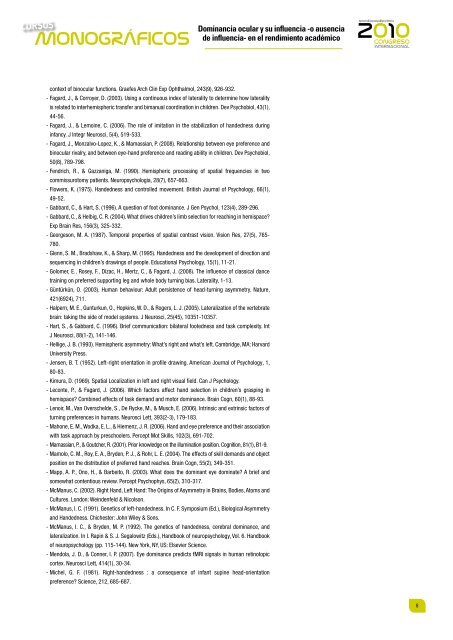Dominancia ocular y su influencia
Dominancia ocular y su influencia
Dominancia ocular y su influencia
Create successful ePaper yourself
Turn your PDF publications into a flip-book with our unique Google optimized e-Paper software.
CURSOS<br />
MONOGRÁFICOS<br />
context of bin<strong>ocular</strong> functions. Graefes Arch Clin Exp Ophthalmol, 243(9), 926-932.<br />
<strong>Dominancia</strong> <strong>ocular</strong> y <strong>su</strong> <strong>influencia</strong> -o ausencia<br />
de <strong>influencia</strong>- en el rendimiento académico<br />
- Fagard, J., & Corroyer, D. (2003). Using a continuous index of laterality to determine how laterality<br />
is related to interhemispheric transfer and bimanual coordination in children. Dev Psychobiol, 43(1),<br />
44-56.<br />
- Fagard, J., & Lemoine, C. (2006). The role of imitation in the stabilization of handedness during<br />
infancy. J Integr Neurosci, 5(4), 519-533.<br />
- Fagard, J., Monzalvo-Lopez, K., & Mamassian, P. (2008). Relationship between eye preference and<br />
bin<strong>ocular</strong> rivalry, and between eye-hand preference and reading ability in children. Dev Psychobiol,<br />
50(8), 789-798.<br />
- Fendrich, R., & Gazzaniga, M. (1990). Hemispheric processing of spatial frequencies in two<br />
commis<strong>su</strong>rotomy patients. Neuropsychologia, 28(7), 657-663.<br />
- Flowers, K. (1975). Handedness and controlled movement. British Journal of Psychology, 66(1),<br />
49-52.<br />
- Gabbard, C., & Hart, S. (1996). A question of foot dominance. J Gen Psychol, 123(4), 289-296.<br />
- Gabbard, C., & Helbig, C. R. (2004). What drives children’s limb selection for reaching in hemispace?<br />
Exp Brain Res, 156(3), 325-332.<br />
- Georgeson, M. A. (1987). Temporal properties of spatial contrast vision. Vision Res, 27(5), 765-<br />
780.<br />
- Glenn, S. M., Bradshaw, K., & Sharp, M. (1995). Handedness and the development of direction and<br />
sequencing in children’s drawings of people. Educational Psychology, 15(1), 11-21.<br />
- Golomer, E., Rosey, F., Dizac, H., Mertz, C., & Fagard, J. (2008). The influence of classical dance<br />
training on preferred <strong>su</strong>pporting leg and whole body turning bias. Laterality, 1-13.<br />
- Güntürkün, O. (2003). Human behaviour: Adult persistence of head-turning asymmetry. Nature,<br />
421(6924), 711.<br />
- Halpern, M. E., Gunturkun, O., Hopkins, W. D., & Rogers, L. J. (2005). Lateralization of the vertebrate<br />
brain: taking the side of model systems. J Neurosci, 25(45), 10351-10357.<br />
- Hart, S., & Gabbard, C. (1996). Brief communication: bilateral footedness and task complexity. Int<br />
J Neurosci, 88(1-2), 141-146.<br />
- Hellige, J. B. (1993). Hemispheric asymmetry: What’s right and what’s left. Cambridge, MA: Harvard<br />
University Press.<br />
- Jensen, B. T. (1952). Left-right orientation in profile drawing. American Journal of Psychology, 1,<br />
80-83.<br />
- Kimura, D. (1969). Spatial Localization in left and right vi<strong>su</strong>al field. Can J Psychology.<br />
- Leconte, P., & Fagard, J. (2006). Which factors affect hand selection in children’s grasping in<br />
hemispace? Combined effects of task demand and motor dominance. Brain Cogn, 60(1), 88-93.<br />
- Lenoir, M., Van Overschelde, S., De Rycke, M., & Musch, E. (2006). Intrinsic and extrinsic factors of<br />
turning preferences in humans. Neurosci Lett, 393(2-3), 179-183.<br />
- Mahone, E. M., Wodka, E. L., & Hiemenz, J. R. (2006). Hand and eye preference and their association<br />
with task approach by preschoolers. Percept Mot Skills, 102(3), 691-702.<br />
- Mamassian, P., & Goutcher, R. (2001). Prior knowledge on the illumination position. Cognition, 81(1), B1-9.<br />
- Mamolo, C. M., Roy, E. A., Bryden, P. J., & Rohr, L. E. (2004). The effects of skill demands and object<br />
position on the distribution of preferred hand reaches. Brain Cogn, 55(2), 349-351.<br />
- Mapp, A. P., Ono, H., & Barbeito, R. (2003). What does the dominant eye dominate? A brief and<br />
somewhat contentious review. Percept Psychophys, 65(2), 310-317.<br />
- McManus, C. (2002). Right Hand, Left Hand: The Origins of Asymmetry in Brains, Bodies, Atoms and<br />
Cultures. London: Weindenfeld & Nicolson.<br />
- McManus, I. C. (1991). Genetics of left-handedness. In C. F. Symposium (Ed.), Biological Asymmetry<br />
and Handedness. Chichester: John Wiley & Sons.<br />
- McManus, I. C., & Bryden, M. P. (1992). The genetics of handedness, cerebral dominance, and<br />
lateralization. In I. Rapin & S. J. Segalowitz (Eds.), Handbook of neuropsychology, Vol. 6. Handbook<br />
of neuropsychology (pp. 115-144). New York, NY, US: Elsevier Science.<br />
- Mendola, J. D., & Conner, I. P. (2007). Eye dominance predicts fMRI signals in human retinotopic<br />
cortex. Neurosci Lett, 414(1), 30-34.<br />
- Michel, G. F. (1981). Right-handedness : a consequence of infant <strong>su</strong>pine head-orientation<br />
preference? Science, 212, 685-687.<br />
8




